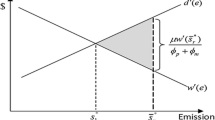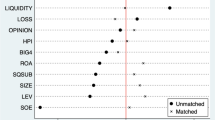Abstract
If a firm can influence its monitorability vis-à-vis an environmental regulator, it is shown that increasing the thoroughness of inspections induces the firm to substitute towards more transparent technologies, whilst increasing their frequency may cause substitution the other way. Perversely, when the effect of such substitution is taken into account, an increase in the frequency of inspections (or, equally, the stringency of penalties) may worsen the firm's environmental performance. The agency should favour more thorough inspections than existing theory suggests, particularly in sectors where the scope for such substitution is great. Moreover, when monitorability adjusts only sluggishly to policy shocks (because it is an embodied characteristic of capital, for example) the environmental impacts of increased frequency and increased thoroughness well over- and under-shoot their respective long-run impacts. In assessing regulatory reform, therefore, it is important to leave sufficient time for the class of adjustments identified to occur. The possibility of overshooting can be used as an alternative to existing ‘regulatory capture’ theories to explain why the efficacy of some classes of regulatory reform may fade through time.
Similar content being viewed by others
Bibliography
Bebchuk, L. A. and L. Kaplow (1993), ‘Optimal Sanctions and Differences in Individuals' Likelihood of Avoiding Detection’,International Review of Law and Economics 13, 217–224.
Cooter, R. and T. Ulen (1990),Law and Economics, Scott, Foresman and Company, London, England.
Friedman, D. D. (1981), ‘Reflections on Optimal Punishment, or: Should the Rich Pay Higher Fines?’, in R. O. Zerbe, ed.,Research in Law and Economics, Greenwich, NY: JAI Press, vol. 3, 182–205.
Garvie, D. and A. Keeler (1993), ‘Incomplete Enforcement with Endogenous Regulatory Choice’. Discussion Paper #873, Institute for Economic Research, Queens University, Kingston, Canada.
Harford, J. D. (1987), ‘Self-Reporting of Pollution and the Firms Behaviour Under Imperfectly Enforceable Regulations’,Journal of Environmental Economics and Management 14, 293–303.
Hay, D. E. and D. J. Morris (1991),Industrial Economics and Organisation, 2nd Edition, Oxford University Press.
Heyes, A. G. (1992),Technological Transparency and Regulation. Mimeo, Department of Economics, McGill University, Montreal.
Humphery, C., S. Turley and P. Moizer (1993), ‘Protecting Against Detection: The Case of Auditors and Fraud’,Accounting, Auditing and Accountability Journal 6(1), 39–62.
Jones, C. A. (1989), ‘Standard-Setting with Incomplete Enforcement Revisited’,Journal of Policy Analysis and Management 8, 72–87.
Kalt, J. P. and M. A. Zupan (1984), ‘Capture and Ideology in the Economic Theory of Politics’,American Economic Review 74(3), 279–300.
Kambhu, J. (1989), ‘Regulatory Standards, Non-Compliance and Enforcement’,Journal of Regulatory Economics 1(2), 103–114.
Lee, D. R. (1984) ‘Monitoring and Budget Maximisation in Pollution Control’,Economic Inquiry 18, 565–575.
Linder, S. H. and M. E. McBride (1984), ‘Enforcement Costs and Regulatory Reform: The Agency and Firm Response’,Journal of Environmental Economics and Management 11(2), 327–346.
Malik, M. S. (1990), ‘Avoidance, Screening and Optimal Enforcement’,Rand Journal of Economics 21(3), 341–353.
Miceli, T. J. (1990), ‘Optimal Prosecution of Defendants Whose Guilt is Uncertain’,Journal of Law, Economics and Organisation 6(1), 187–201.
Mintz, J. A. (1988), ‘Agencies, Congress and Regulatory Enforcement: A Review of EPA's Hazardous Waste Enforcement Effort, 1970–1987’,Environmental Law 18, 683–759.
Posner, R. (1974), ‘Theories of Economic Regulation’,Bell Journal of Economics 5, 335–358.
Russell, C. S., W. J. Vaughan and W. Harrington (1986),Enforcing Pollution Control Laws, Johns Hopkins University Press, Baltimore, MD.
Russell, C. S. (1990), ‘Monitoring and Enforcement’, Chapter 7 in P. R. Portney, ed.,Public Policies for Environmental Protection, Washington DC: Resources for the Future.
Segerson, K. (1988), ‘Uncertainty and Incentives for Nonpoint Pollution Control’,Journal of Environmental Economics and Management 15, 87–98.
Shaffer, S. (1990), ‘Regulatory Compliance with Non-linear Penalties’,Journal of Regulatory Economics 2(1), 99–103.
Stigler, G. (1975),The Citizen and the State, Chicago University Press.
Storey, D. J. and P. J. McCabe (1980), ‘The Criminal Waste Discharger’,Scottish Journal of Political Economy 27, 30–40.
Strock, J. M. (1990), ‘Protecting the Environment: EPA After 20 Year’,Trial (August), 22–27.
Williamson, O. E. (1987),Antitrust Economics (1st Edition), Basil Blackwell Ltd., Oxford, England.
Yaeger, P. E. (1991),The Limits of the Law: The Public Regulation of Private Pollution, Cambridge University Press, New York, NY.
Author information
Authors and Affiliations
Rights and permissions
About this article
Cite this article
Heyes, A.G. Environmental enforcement when ‘inspectability’ is endogenous: A model with overshooting properties. Environ Resource Econ 4, 479–494 (1994). https://doi.org/10.1007/BF00691924
Issue Date:
DOI: https://doi.org/10.1007/BF00691924




